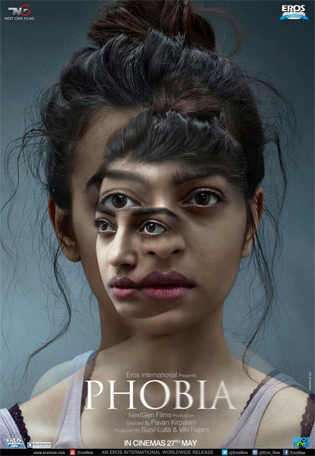 Starring Radhika Apte, Satyadeep Mishra
Starring Radhika Apte, Satyadeep Mishra
Directed by Pawan Kripalani
The fear of the unknown has perpetually incited some of the most exciting cinema the worldover. Way back in 1967 Audrey Hepburn played a blind woman trapped in her own home with intruders in Terence Young’s Wait Until Dark.
But what if the intruder is only in the purported victim’s mind? What if the shadows under your bed exist only in your head?
It takes an abundance of guts to make a Hindi ‘Bollywood’ film (not sure if this is what Phobia aspires to be) where the main characters are a troubled woman and her phobia. Mehak (Apte) fears getting out of her home. Luckily the actress who plays Mehak has no fear of the unknown. Radhika Apte takes charge of Mehak’s insecurities with unfaltering equilibrium.
To keep us constantly riveted to Mehak’s ordeal without resorting to the standard clichés of Bollywood horror cinema (you know, the creaking doors, crashing glass, eerie banshee sounds, ear-splitting screams…) is an accomplishment worth of a 24-gun salute. Take a bow, Mr Kripalani.
Then there is Radhika Apte. So much in control of Mehak’s uncontrollable paranoia, I forgot this was a character being played by an actor, and a very fine one at that. This is as good a time as any to state that Radhika Apte is better at baring a troubled woman’s uncertainties and fears than any other contemporary actress.
What Radhika does with her character Mehak’s fears is to make them palpable and immediate without resorting to any extraneous mannerisms of terror and dread associated with the horror genre. No widening of the eyes, biting of the lips, screaming and ranting. Very often the director (God bless his diabolic plans) shrouds Apte’s traumatized inner world with a deathly silence, so that we are watching just the woman and her terror, fully naked …and stark.
Eerie is the word.
I remember Urmila Matondkar when she was left alone in a house with her fears and phobias in Ram Gopal Varma’s Kaun. Urmila was all over the place with her screams and gesticulations. Apte goes the other way. She gives us no external clues to her character’s state of mind. Instead she enters Mehak’s world and invites us in….Radhika Apte takes us through Mehak’s journey into her fears, when we know she cannot be completely trusted. She has exceptional support from the very talented and criminally under-used Satyadeep Mishra as her friend trying to grope his way through her darkness. Mishra creates a specific space for his character in spite of the cramped claustrophobic walls that Apte’s character builds around her existence.
The protagonist’s other ally is Jayakrishna Gummadi’s camera which swirls around Mehak’s insecurities vigilantly but unobtrusively. The technique applied to the tale of nameless terror is so subtle and sharp, we never notice it.
Phobia constantly veers the narration into slippery grounds, not to confuse or mislead but to imbue an aura of intangible anxiety in the viewer. Director Kripalani uses contextual terror rather than generating fear accessoried sources.For years we’ve wondered why the horror genre in Hollywood has not broken free of its amateurishness.
Wonder no more. Take a trip of bonafide terror and witness the birth of a new psychological disorder.
Apte-phobia.










